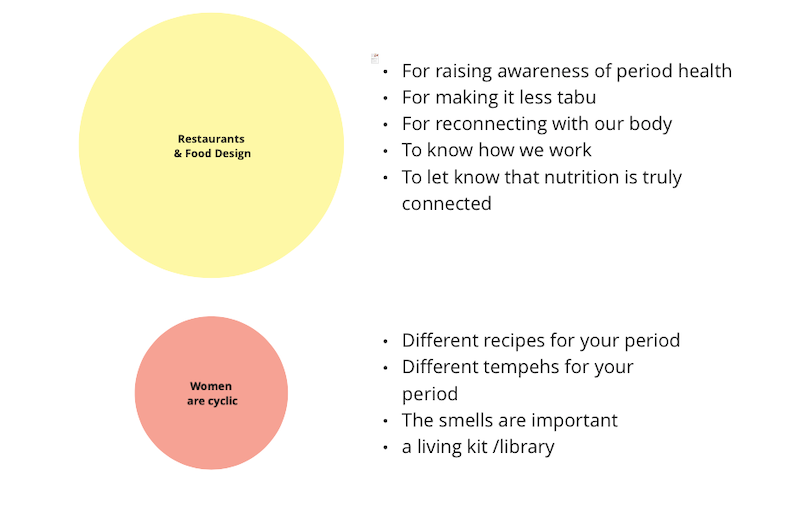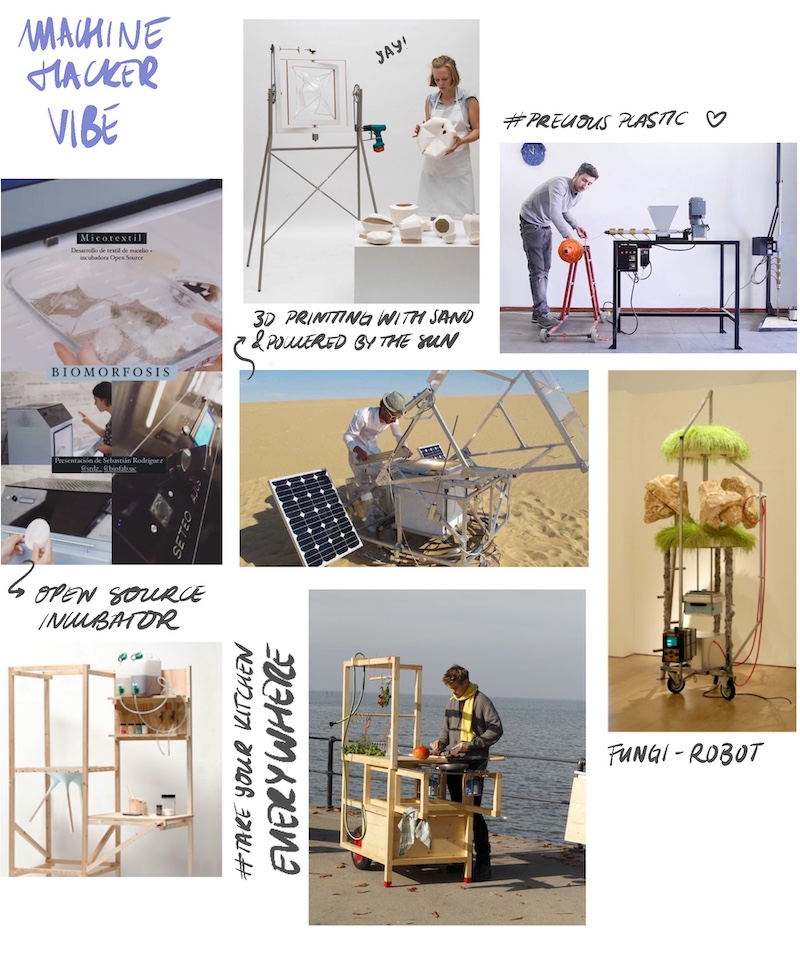11. Implications and aplications
FERMENTING MY IDEAS¶
This week was our first approach to our final project...OMG.
CONCEPT DEVELOPMENT¶

It almost look like Grashopper haha
FIRST STEP: Select your areas related
During our co-working session we selected some different areas from the ones that we looked into during Fabricademy, but also some more that we could add.

SECOND STEP, MOODBOARD: inspiration & flavour
THIRD STEP, CONCEPT: the project idea or story
WHAT

A circular plant-based gastronomic service. A ferment-lab, cuisine and bio-lab where food and design intersects.
It will show how a plant-based diet can be both nutritious and delicious giving whole and symbiotic meals. While fermenting and cooking, food waste is created so they'd be transformed in biomaterials to develop the take-away service.
Achieving a circular service would be achieved by the fabrication of our own machines and tools, in order to help us in the process of fermenting and recycling the waste into the biomaterials. Also controlling the materia as an input for the result making it as a part of our own ecosystem.
WHY
This project is stated as a vegan consumer and as a bio-designer. As a vegan consumer I cannot find good vegan options in many places, and I find myself in a lot of occasions not having a proper meal. My cooking skills were improved during the process of creating whole and nutritious meals for myself, but understanding that all, as humans, need to take care of what we put inside us: it doesn't matter if you're vegan or not.
"Probiotics": they're can be found in food, and not just in pills. A probiotic food is the one that has been fermented which are high in bacterias good for our microbiota.
As a bio-designer with cooking skills, the idea of the amount of food waste generated was harmful, but also an opportunity to take my main input from.
HOW

1º Approach:
- Selecting three or four different types of ferments that in their growing processes are related.
- Studying the process of creation and the steps needed and finding a way to merge them in order to make the most of the energy used.
- Designing different machines and tools that can be used for all those fermentations or cooking. (The machines would be powered or organized by priority. )
- What waste would be created? What biomaterials can be done? What kind of ingredients would be interesting to develop them?
- Choosing the meals that can be done with those ingredients
- Making symbiotic meals with pre and probiotics
- Cooking and giving whole nutritious meals while raising awareness of the importance of probiotics in our plates.
2º Can I be part of the Foodshift programm for 2030 please??

- Stand
- Food-truck
- 1 floor
- 2 floors
WHO

- For the vegan community that don't find quality food in everyday spaces (fairs, exhibitions, maybe cities or towns...)
- For those that believe that healthy food is just eating saldas...To let them know what they're missing.
- To those whose friends or partners are, but they need to eat good too.
- To (maybe) the pets keep us company.
- To the world, by opening the chance of creating more harmless meals
- For me, and making my two dreams come true.
STAKEHOLDERS¶


WHY FERMENTS?¶
WHAT IS THE MICROBIOTA?
The microbiota is the community of living microorganisms that inhabit different sites of living beings, such as the human body. They have a symbiotic relationship with the host or being in which they live. Both benefit from each other and are dependent on each other for survival. They aid digestion, produce vitamins and protect against invasion by other micro-organisms that may be harmful.
In the human body, we have approximately 100 trillion micro-organisms, which means that we have more bacteria than our own cells. All parts of our body that are in contact with the outside world are loaded with microbiota, such as the skin, vagina, digestive tract and other areas.
For several years now, the microbiota has been considered as another organ of our body.
FUNCTIONS
Depending on the area of our body, it has different functions such as the process of digestion of food, the good condition of our digestive system, the regulation of the immune system... One of which is the regulation of the area in which it is housed, creating balance with the outside world. If we are able to maintain a stable and healthy microbiota, the external agents that can affect us will be drastically reduced.
The microbiota of the intestinal tract is one of the main microbiota as it is in continuous contact with harmful bacteria, toxins, allergens and viruses. So it plays a major role in our immune system."
Information stracted from Macrobiotic Institute Nishime
CONECTING IT TO WOMEN HORMONAL HEALTH¶

In ancient times the female body was valued as sacred and life cycles were experienced as a source of knowledge, connection and attunement with nature. Nowadays menstruation has been dissociated from our inner health and the experience of it, associating it only with the bleeding phase, when in reality all phases are important. In order to reconnect, we need to go deeper into ourselves and get to know ourselves, to know what is going on inside us and to promote it in order to enhance our health.
The menstrual cycle is considered to be the fifth vital sign so it gives us a lot of information about what may be going on inside us.
One of the ways we can take action is through nutrition to regulate hormonal health, and therefore the menstrual cycle.
It is through my own personal journey of reconnecting with my period, recovering my hormonal health after major imbalances... that I propose through this project the union of biodesign and nutrition to communicate and bring this useful tool to women. Through recipes made with ingredients according to each phase (4 in total) health and knowledge are brought closer in a new gastronomic experience.


I sent a survey by Google forms in order to collect the knowledge around ferments and the conexion between nutriotion and hormonal health.
CALENDAR (S)¶
This is the calendar that I made after the review where I selected the food mentioned before and organized the experimentation that I needed to do in Christmas time.

Although after Christmas holidays and a lot of fermentation books, I changed a little bit my focus: edible mycellium as the fermentor and basing my recipes on womens hormonal health So it changed to this:

Research¶
-
Blas Studio. 3d printing urban waste and mycellium.
- The Rise Of Biodesign - Growing Our Way To A More Sustainable Future
- Eco-age
- THE FUTURE OF FOOD IS LOW-CARBON, CIRCULAR & PLANT BASED!
- THe vegetarian resource group
Tempeh "gurus" and biodesign: - Wendy, alumni 2018 - Jiwei Zhou
Vegan places that integrates or either fermentation or biomaterials:
- The Living food Barcelona: "We use different techniques, most are adaptations of artisanal dairy cheese making techniques, but in our case, we make them from raw, organic nuts, activated with seawater and fermented with our own blends of micro-organisms and spores, certified vegan. There are also a variety of vegetable tempehs with activated seeds and our Tongbaechu kimchi. We make them in the same way as our cheeses, following the "living food" concept, as they are raw/live (kimchi), unpasteurised, full of nutrients and probiotics. They sell to different restaurants and have their own Fermentation Lab.
- Hervibore Lab
- Club Cultured
- The Arty Vegan
- (The Domingo Club)[https://domingoclub.com]
- Silo as a Zero Waste restaurant
- The sisters as a vegan and Zero Waste restaurant

Fermentation Tools:
- Useful tools
- Sprouting
- Deshidratadora
- Open Source Incubator
- Open Source Incubator from Biofab UC
- Multiprocessing Machine from TextileAmsterdam
Recipes: -Vegan cheesecake fermented with kombucha

